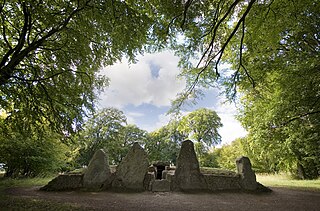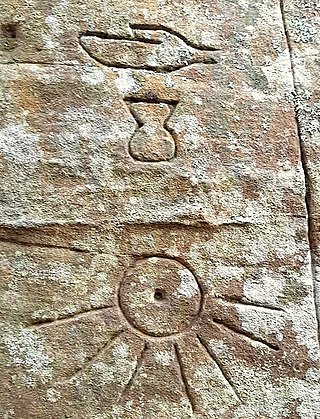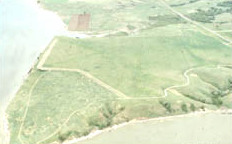Related Research Articles

America's Stonehenge is a privately owned tourist attraction and archaeological site consisting of a number of large rocks and stone structures scattered around roughly 30 acres within the town of Salem, New Hampshire, in the United States. It is open to the public for a fee as part of a recreational area which includes snowshoe trails and an alpaca farm.

Long barrows are a style of monument constructed across Western Europe in the fifth and fourth millennia BCE, during the Early Neolithic period. Typically constructed from earth and either timber or stone, those using the latter material represent the oldest widespread tradition of stone construction in the world. Around 40,000 long barrows survive today.

Archaeological forgery is the manufacture of supposedly ancient items that are sold to the antiquities market and may even end up in the collections of museums. It is related to art forgery.

The Crow Creek massacre occurred around the mid-14th century AD and involved Native American groups at a site along the upper Missouri River in the South Dakota area; it is now within the Crow Creek Indian Reservation. Crow Creek Site, the site of the massacre near Chamberlain, is an archaeological site and a U.S. National Historic Landmark, located at coordinates 43°58′48″N 99°19′54″W. An excavation of part of the site was done in the 1950s, at the time of dam construction on the river. Additional excavations were conducted in 1978 and later.
Feminist archaeology employs a feminist perspective in interpreting past societies. It often focuses on gender, but also considers gender in tandem with other factors, such as sexuality, race, or class. Feminist archaeology has critiqued the uncritical application of modern, Western norms and values to past societies. It is additionally concerned with increasing the representation of women in the discipline of archaeology, and reducing androcentric bias within the field.

Anglo-Saxon runes or Anglo-Frisian runes are runes used by the Anglo-Saxons and Medieval Frisians as an alphabet in their native writing system, recording both Old English and Old Frisian. Today, the characters are known collectively as the futhorc from the sound values of the first six runes. The futhorc was a development from the older co-Germanic 24-character runic alphabet, known today as Elder Futhark, expanding to 28-characters in its older form and up to 34-characters in its younger form. In contemporary Scandinavia, the Older Futhark developed into a shorter 16-character alphabet, today simply called Younger Futhark.

Spiro Mounds is an Indigenous archaeological site located in present-day eastern Oklahoma. The site was built by people from the Arkansas Valley Caddoan culture. that remains from an American Indian culture that was part of the major northern Caddoan Mississippian culture. The 80-acre site is located within a floodplain on the southern side of the Arkansas River. The modern town of Spiro developed approximately seven miles to the south.

The Grand Village of the Illinois, also called Old Kaskaskia Village, is a site significant for being the best documented historic Native American village in the Illinois River valley. It was a large agricultural and trading village of Native Americans of the Illinois confederacy, located on the north bank of the Illinois River near the present town of Utica, Illinois. French explorers Louis Joliet and Father Jacques Marquette came across it in 1673. The Kaskaskia, a tribe of the Illiniwek people lived in the village. It grew rapidly after a French mission and fur trading post were established there in 1675, to a population of about 6,000 people in about 460 houses. Around 1691 the Kaskaskia and other Illiniwek moved further south, abandoning the site due to pressure from an Iroquois invasion from the northeast.
A number of runestones have been found in Oklahoma. All of them are of modern origin dating to the 19th century "Viking revival" or were produced by 19th-century Scandinavian settlers.

Community archaeology is archaeology by the people for the people. The field is also known as public archaeology. There is debate about whether the terms are interchangeable; some believe that community archaeology is but one form of public archaeology, which can include many other modes of practice, in addition to what is described here. The design, goals, involved communities, and methods in community archaeology projects vary greatly, but there are two general aspects found in all community archaeology projects. First, community archaeology involves communities "in the planning and carrying out of research projects that are of direct interest to them". Second, community archaeologists generally believe they are making an altruistic difference. Many scholars on the subject have argued that community collaboration does not have a pre-set method to follow. Although not found in every project, there are a number of recurring purposes and goals in community archaeology. Similarities are also found in different countries and regions—due to commonalities in archaeological communities, laws, institutions, and types of communities. It has also been suggested that public archaeology can be defined in a broad sense as the production and consumption of archaeological "commodities".

Cedarville is the southeasternmost village in Plymouth, Massachusetts, United States. It is bounded to the north by Ellisville Road and Hedges Pond, to the south by the town of Bourne, to the west by Little Herring Pond and Great Herring Pond, and to the east by Cape Cod Bay.
Alice Beck Kehoe is a feminist anthropologist and archaeologist. She has done considerable field research among Native American peoples in the upper plains of the US and Canada, and has authored research volumes on Native American archaeology and Native American history. She is also the author of several general anthropology and archaeology textbooks.

Heather Burke is an Australian historical archaeologist and a professor in the College of Humanities, Arts and Social Sciences at Flinders University.

Archaeology or archeology is the study of human activity through the recovery and analysis of material culture. The archaeological record consists of artifacts, architecture, biofacts or ecofacts, sites, and cultural landscapes. Archaeology can be considered both a social science and a branch of the humanities. It is usually considered an independent academic discipline, but may also be classified as part of anthropology, history or geography.

Indigenous archaeology is a sub-discipline of Western archaeological theory that seeks to engage and empower indigenous people in the preservation of their heritage and to correct perceived inequalities in modern archaeology. It also attempts to incorporate non-material elements of cultures, like oral traditions, into the wider historical narrative. This methodology came out of the global anti-colonial movements of the 1970s and 1980s led by aboriginal and indigenous people in settler-colonial nations, like the United States, Canada, and Australia. Major issues the sub-discipline attempts to address include the repatriation of indigenous remains to their respective peoples, the perceived biases that western archaeology's imperialistic roots have imparted into its modern practices, and the stewardship and preservation of indigenous people's cultures and heritage sites. This has encouraged the development of more collaborative relationships between archaeologists and indigenous people and has increased the involvement of indigenous people in archaeology and its related policies.

The Plum Island Eagle Sanctuary is a 52-acre island in the Illinois River owned by the Illinois Audubon Society. It was purchased March 24, 2004 to act as a wildlife sanctuary, to protect foraging habitat for wintering bald eagles. It is close to Matthiessen State Park and adjacent to Starved Rock State Park.

Chinese archaeology has been practiced since the Song dynasty (960–1279) with early practices of antiquarianism. Although native Chinese antiquarianism developed some rigorous methods of unearthing, studying, and cataloging ancient artifacts, the field of archaeology in China never developed into a branch of study outside of Chinese historiography. Native Chinese antiquarian studies waned after the Song period but were revived during the Qing dynasty (1644–1912). Rigorous standards of modern Chinese archaeology were first developed at the turn of the 20th century by Chinese archaeologists educated in the West and in the early Republic of China (1912–1949).

Craig Weatherhill was a Cornish antiquarian, novelist and writer on the history, archaeology, place names and mythology of Cornwall.
Funerary archaeology is a branch of archaeology that studies the treatment and commemoration of the dead. It includes the study of human remains, their burial contexts, and from single grave goods through to monumental landscapes. Funerary archaeology might be considered a sub-set of the study of religion and belief. A wide range of expert areas contribute to funerary archaeology, including epigraphy, material culture studies, thanatology, human osteology, zooarchaeology and stable isotope analysis.
African diaspora archaeology is the study of the archaeology of the African diaspora; Africans that were forcibly transported throughout the world by either the Atlantic slave trade, the Trans-Saharan slave trade, the Indian Ocean slave trade, or their descendants. Although pertaining to worldwide dispersal, the majority of research comes from Africa and the Americas, with very little from Europe and Asia.
References
- ↑ "AIA Event Listings - The Bourne Stone - Bourne Historical Society". www.archaeological.org. Retrieved 2015-12-16.
- ↑ "Bourne Stone continues to baffle the experts". capecodtimes.com. Retrieved 2015-12-16.
- ↑ Yankee, Wicked (2012-10-31). "Wicked Yankee: The Bourne Stone - Bourne, Ma". Wicked Yankee. Retrieved 2015-12-16.
- ↑ Larry J. Zimmerman (2007). "Unusual or extreme beliefs about the past". In Chip Colwell-Chanthaphonh (ed.). Collaboration in archaeological practice: engaging descendant communities. Altamira Press. p. 70. ISBN 978-0-7591-1054-0.
- ↑ Chartier, Craig (January 2016), New Thoughts on an Old Rock or Confessions of an Ignorant Skeptic (PDF), Plymouth Archaeological Rediscovery Project